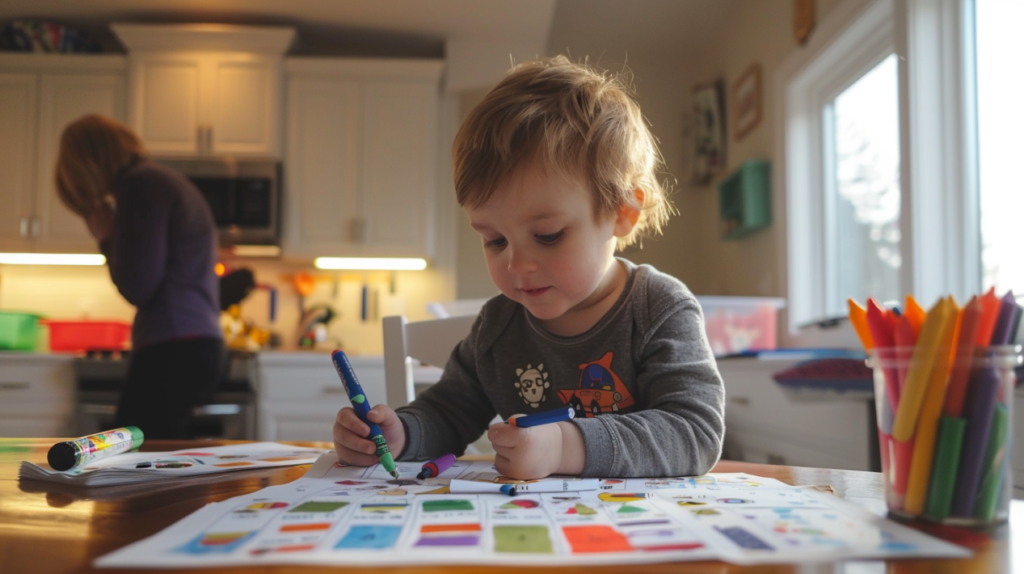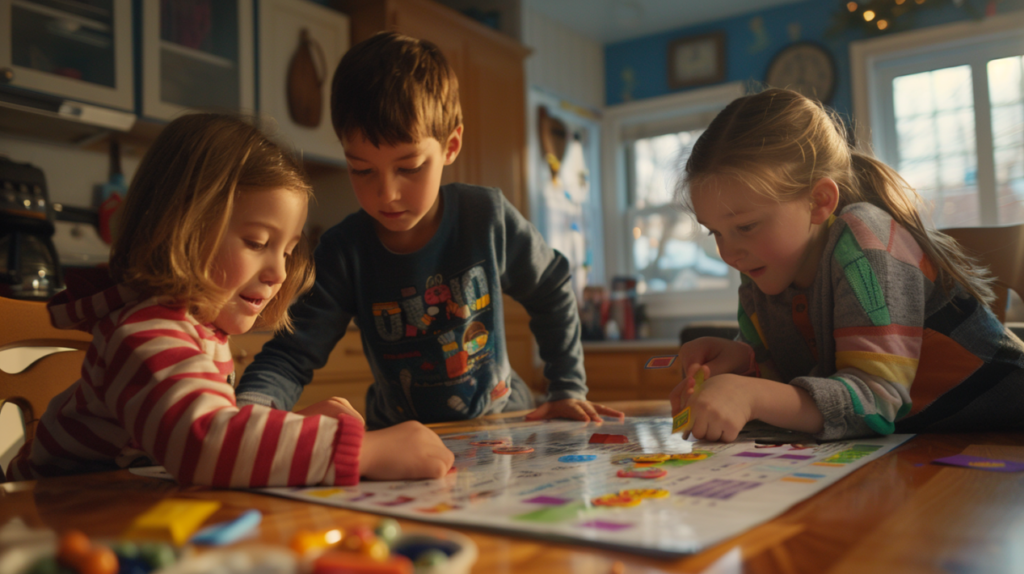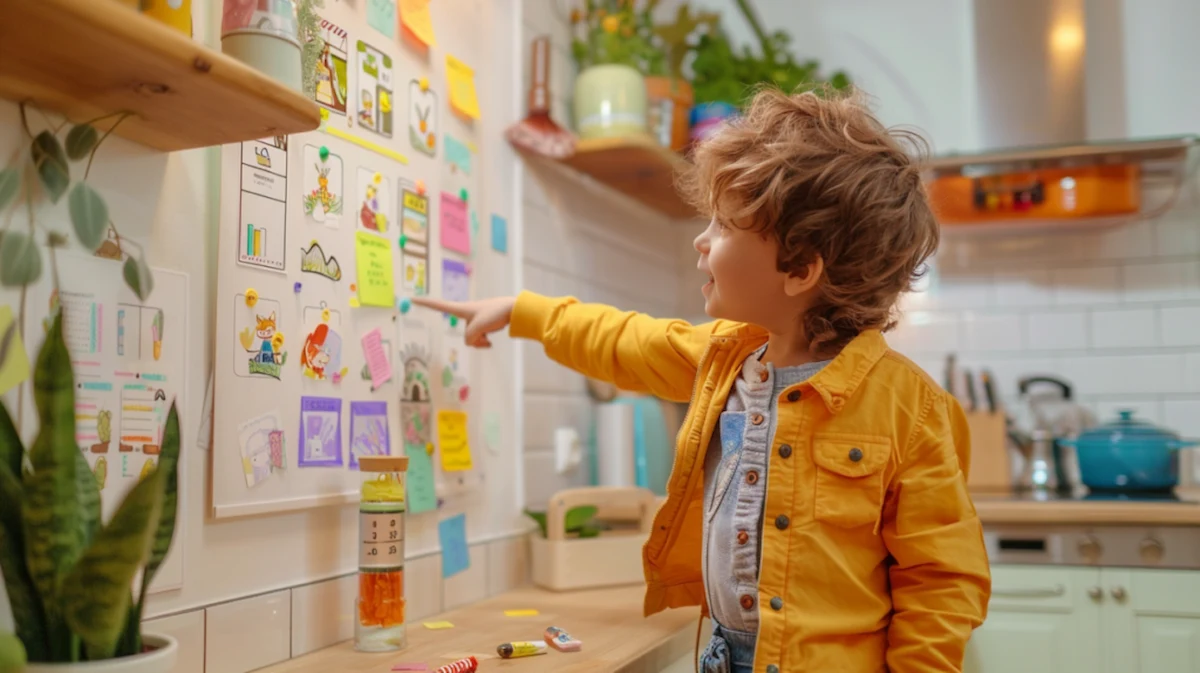Keeping your home organized while teaching your kids responsibility doesn’t have to be a daunting task. In fact, it can be fun, creative, and even rewarding for the whole family! DIY kids chore charts are a fantastic way to help kids understand their responsibilities, develop time management skills, and feel a sense of accomplishment. But let’s face it—generic chore charts can get boring fast. That’s where DIY kids chore charts come in!
In this post, we’ve rounded up 10 creative DIY kids chore chart ideas that are not only easy to make but also customizable to fit your family’s unique needs. Whether you’re looking for a magnetic DIY kids chore chart for toddlers, a printable template for busy parents, or a rewards system to motivate older kids, we’ve got you covered. These DIY kids chore chart ideas are designed to make chores feel less like work and more like a fun, engaging activity.
Ready to transform your home into an organized haven while teaching your kids valuable life skills? Let’s dive into these creative and practical DIY kids chore chart ideas!
Magnetic DIY Kids Chore Chart for Customizable Fun

If you’re looking for a DIY kids chore chart that’s both flexible and fun, a magnetic chore chart is the perfect solution! Magnetic DIY kids chore charts are highly customizable, making them ideal for families with kids of different ages and interests. Plus, they’re reusable, so you can update tasks as your kids grow or your family’s needs change. Here are four creative ideas to get you started with your very own DIY kids chore chart:
Idea 1: Magnetic Whiteboard with Colorful Magnets
A magnetic whiteboard is the foundation of this DIY chore chart. Here’s how to make it work:
- Step 1: Use a large magnetic whiteboard as your base.
- Step 2: Write or print out chore labels (e.g., “Make Bed,” “Set Table,” “Put Away Toys”) and attach small magnets to the back.
- Step 3: Assign each child a color-coded magnet to move their chores from the “To Do” to the “Done” column.
- Why It Works: The visual movement of magnets gives kids a sense of accomplishment and makes tracking progress easy.
Idea 2: Magnetic Task Cards with Pictures for Younger Kids
For toddlers and preschoolers who can’t read yet, picture-based task cards are a game-changer.
- Step 1: Create or print out small cards with images of chores (e.g., a toothbrush for brushing teeth, a toy for tidying up).
- Step 2: Attach magnets to the back of each card.
- Step 3: Place the cards on the whiteboard in the “To Do” section and let your child move them to the “Done” side when they complete a task.
- Why It Works: The visual cues help younger kids understand their responsibilities without needing to read.
Idea 3: Add a Rewards Section with Star Magnets
Motivate your kids by incorporating a rewards system into your magnetic chore chart.
- Step 1: Dedicate a section of the whiteboard to “Rewards.”
- Step 2: When a child completes a chore, they can add a star magnet to their rewards column.
- Step 3: Set a goal (e.g., 10 stars = a small prize or extra screen time).
- Why It Works: The tangible reward system encourages consistency and makes chores feel like a game.
Idea 4: Include a “Done” Column to Track Progress
A “Done” column is a simple but effective way to help kids see their progress throughout the day.
- Step 1: Divide your whiteboard into three sections: “To Do,” “In Progress,” and “Done.”
- Step 2: Let your kids move their chore magnets across the board as they complete tasks.
- Step 3: Celebrate when all the magnets reach the “Done” column!
- Why It Works: The clear visual progression helps kids stay motivated and organized.
Why Magnetic Chore Charts Are a Family Favorite
DIY kids chore charts like magnetic ones are not only practical but also highly engaging for kids. They allow for endless customization, making it easy to adapt the chart as your family’s needs evolve. Plus, the tactile experience of moving magnets adds an element of fun that keeps kids excited about completing their chores.
Ready to create your own DIY kids chore chart? Grab a whiteboard, some magnets, and let your creativity flow!
Printable DIY Kids Chore Chart Templates for Busy Parents

Life as a parent is busy, and sometimes there just aren’t enough hours in the day to create a DIY kids chore chart from scratch. That’s where printable chore chart templates come to the rescue! These ready-made templates are not only time-saving but also customizable, making them perfect for families on the go. Here are four creative ways to use printable DIY kids chore charts to keep your home organized and your kids on track:
Idea 1: Download Free Printable Chore Charts with Fun Themes
Kids are more likely to engage with a chore chart if it’s visually appealing and fun.
- Step 1: Search for free printable chore charts online (many parenting blogs and websites offer them).
- Step 2: Choose a theme that matches your child’s interests, such as superheroes, animals, or space.
- Step 3: Print the chart and display it in a visible spot, like the fridge or a bulletin board.
- Why It Works: The themed designs make chores feel less like work and more like an adventure.
Idea 2: Use Editable PDFs to Customize Chores for Each Child
Every child is different, and their chores should reflect their age and abilities.
- Step 1: Find editable PDF chore chart templates online (many are free or low-cost).
- Step 2: Open the PDF on your computer and type in your child’s name and specific chores.
- Step 3: Print the customized chart and let your child start tracking their tasks.
- Why It Works: Editable templates allow you to tailor the chart to your family’s unique needs.
Idea 3: Create a Weekly or Monthly Chart to Teach Time Management
Help your kids learn time management by using a printable chart that spans a week or month.
- Step 1: Choose a printable template with daily or weekly sections.
- Step 2: Assign chores for each day and let your child check them off as they go.
- Step 3: At the end of the week or month, review their progress and celebrate their achievements.
- Why It Works: A longer-term chart teaches kids to plan ahead and stay consistent.
Idea 4: Laminate Printables for a Reusable, Eco-Friendly Option
Save time and reduce waste by making your printable chore chart reusable.
- Step 1: Print your chosen template on sturdy paper.
- Step 2: Laminate the chart or place it in a clear plastic sleeve.
- Step 3: Use dry-erase markers to check off chores, then wipe the chart clean at the end of the week.
- Why It Works: Laminated charts are durable, eco-friendly, and perfect for busy households.
Why Printable Chore Charts Are a Parent’s Best Friend
Printable DIY kids chore charts are a lifesaver for busy parents who want to teach their kids responsibility without spending hours on DIY projects. They’re easy to find, customizable, and can be tailored to fit any family’s schedule or preferences. Plus, they’re a great way to involve kids in household tasks while keeping things organized and stress-free.
Ready to get started with your own DIY kids chore chart? A quick online search will lead you to countless free and paid printable chore chart templates. Print, customize, and watch your kids take ownership of their chores!
DIY Kids Chore Chart with Rewards System to Motivate Kids

Let’s be honest—getting kids excited about chores can be a challenge. But when you add a rewards system to the mix, everything changes! A DIY kids chore chart with built-in incentives not only motivates kids to complete their tasks but also teaches them the value of hard work and responsibility. Here are four creative ways to incorporate a rewards system into your DIY kids chore chart:
Idea 1: Sticker Chart for Instant Gratification
Stickers are a classic and effective way to reward younger kids for completing chores.
- Step 1: Create a simple chart with your child’s name and a list of chores.
- Step 2: Assign a sticker for each completed task.
- Step 3: Set a goal (e.g., 10 stickers = a small prize or special treat).
- Why It Works: The immediate reward of a sticker gives kids a sense of accomplishment and keeps them motivated.
Idea 2: Points-Based System for Older Kids
For older kids, a points-based system adds an extra layer of excitement and strategy.
- Step 1: Assign a point value to each chore based on difficulty (e.g., making the bed = 5 points, vacuuming = 10 points).
- Step 2: Let your kids track their points on the chart as they complete tasks.
- Step 3: Allow them to “cash in” their points for rewards, such as extra screen time, a toy, or a special outing.
- Why It Works: The points system teaches kids about earning and saving while giving them a sense of control over their rewards.
Idea 3: Bonus Chores for Extra Rewards
Encourage your kids to go above and beyond by offering bonus chores for extra rewards.
- Step 1: Include a “Bonus Chores” section on your chore chart with tasks like organizing the playroom or helping with yard work.
- Step 2: Assign a higher reward value to these tasks (e.g., double stickers or extra points).
- Step 3: Celebrate their extra effort with a special reward or privilege.
- Why It Works: Bonus chores teach kids the value of hard work and initiative while keeping them engaged.
Idea 4: Jar System for Tangible Rewards
A jar system is a fun and visual way to track rewards.
- Step 1: Use a clear jar and small items like marbles, pom-poms, or coins to represent completed chores.
- Step 2: Add one item to the jar each time your child completes a task.
- Step 3: When the jar is full, reward your child with a special treat or activity.
- Why It Works: The growing collection of items in the jar provides a tangible representation of their progress and keeps them motivated.
Why Rewards Systems Work Wonders
A rewards system transforms chores from a mundane task into an exciting challenge. It gives kids a clear goal to work toward and helps them understand the connection between effort and reward. Plus, it’s a great way to teach responsibility, time management, and the value of hard work—all while keeping your home organized with a DIY kids chore chart!
Ready to create your own DIY kids chore chart with a rewards system? Choose one of these ideas, customize it to fit your family’s needs, and watch your kids eagerly tackle their chores!
Visual Chore Charts for Younger Kids
For toddlers and preschoolers, traditional chore charts with written tasks can be overwhelming. That’s where visual chore charts come in! These charts use pictures, colors, and simple designs to help young children understand their responsibilities without needing to read. Visual chore charts are not only effective but also fun and engaging for little ones. Here are four creative ideas to get you started:
Idea 1: Picture-Based Charts for Non-Readers
Young kids respond well to images, making picture-based charts a perfect fit.
- Step 1: Create or print out small cards with images of common chores (e.g., a toothbrush for brushing teeth, a toy for tidying up, a plate for setting the table).
- Step 2: Attach the cards to a poster board, whiteboard, or magnetic surface.
- Step 3: Let your child move the cards to a “Done” section or flip them over when they complete a task.
- Why It Works: The visual cues make it easy for young kids to understand what’s expected of them.
Idea 2: Flip Chart for Task Sequencing
A flip chart is a great way to teach kids the concept of sequencing and completing tasks in order.
- Step 1: Create a chart with two columns: “To Do” and “Done.”
- Step 2: Use picture cards or drawings to represent each chore.
- Step 3: Attach the cards with binder rings or clips so your child can flip them from one side to the other as they complete tasks.
- Why It Works: The flipping action is satisfying for kids and helps them visualize their progress.
Idea 3: Color-Coded Charts for Easy Understanding
Color-coding is a simple yet effective way to organize chores for younger kids.
- Step 1: Assign a color to each type of chore (e.g., green for cleaning, blue for personal hygiene, yellow for helping with meals).
- Step 2: Use colored cards, stickers, or markers to represent each task on the chart.
- Step 3: Teach your child to match the colors to the chores they need to complete.
- Why It Works: The colors make it easy for kids to identify and categorize their tasks.
Idea 4: “First, Then” Charts for Task Prioritization
A “First, Then” chart helps young kids understand the order of tasks and builds a sense of routine.
- Step 1: Create a chart with two sections: “First” and “Then.”
- Step 2: Place a picture of the chore they need to do first (e.g., “Put Away Toys”) in the “First” section.
- Step 3: Place a picture of a fun activity or reward (e.g., “Play Outside”) in the “Then” section.
- Step 4: Encourage your child to complete the “First” task before moving on to the “Then” activity.
- Why It Works: This approach teaches kids about prioritization and helps them stay focused.
Why Visual Chore Charts Are Perfect for Younger Kids
DIY kids chore charts, especially visual ones, are designed with young children in mind. They use simple, engaging elements like pictures, colors, and hands-on activities to make chores feel less intimidating and more like a game. These DIY kids chore charts not only help kids understand their responsibilities but also build their confidence and independence.
Ready to create your own visual DIY kids chore chart? Grab some pictures, colors, and a little creativity, and watch your little ones take pride in completing their tasks!
Family DIY Kids Chore Chart for Siblings and Large Families

Managing chores in a household with multiple kids can feel like herding cats—but it doesn’t have to be chaotic! A DIY kids chore chart, especially a family one, is the perfect way to keep everyone organized, ensure fairness, and teach teamwork. Whether you have two kids or a full house, these creative ideas will help you create a DIY kids chore chart system that works for your family. Here are four practical and fun ways to get started:
Idea 1: Rotating Chore Wheel for Fairness
A rotating chore wheel ensures that everyone gets a turn at different tasks, preventing complaints about fairness.
- Step 1: Create a circular chart divided into sections, with each section listing a chore (e.g., “Dishes,” “Vacuuming,” “Taking Out Trash”).
- Step 2: Assign each child a section or use clips with their names to mark their current chore.
- Step 3: Rotate the wheel weekly or daily to assign new tasks.
- Why It Works: The rotation system keeps chores fresh and ensures no one feels stuck with the same task all the time.
Idea 2: Shared Whiteboard for Tracking Progress
A shared whiteboard is a great way to keep everyone on the same page—literally!
- Step 1: Use a large whiteboard to list all family members and their assigned chores for the week.
- Step 2: Let kids check off their tasks as they complete them.
- Step 3: Hold a weekly family meeting to review progress and celebrate achievements.
- Why It Works: The shared board promotes transparency and accountability, making it easy for everyone to see who’s doing what.
Idea 3: Color-Coded Tasks for Clarity
Color-coding is a simple yet effective way to organize chores in a large family.
- Step 1: Assign each child a color (e.g., blue for Emma, green for Liam, yellow for Sophia).
- Step 2: Use colored markers, stickers, or cards to represent their chores on the chart.
- Step 3: Display the chart in a central location so everyone knows their responsibilities.
- Why It Works: The color system makes it easy for kids to identify their tasks at a glance.
Idea 4: Family Reward System for Teamwork
Encourage teamwork by creating a family reward system where everyone works together toward a shared goal.
- Step 1: Set a collective goal (e.g., “Complete 50 chores this week”).
- Step 2: Track progress on a chart or jar system (e.g., add a marble to a jar for each completed chore).
- Step 3: Celebrate with a family reward, like a movie night, pizza party, or trip to the park.
- Why It Works: The shared goal fosters teamwork and teaches kids the value of working together.
Why Family Chore Charts Are a Game-Changer
A DIY kids chore chart, especially a family one, is more than just a tool for keeping your home organized—it’s a way to teach kids responsibility, fairness, and teamwork. By involving everyone in the process, you create a sense of shared ownership and make chores feel less like a burden and more like a family effort. Plus, it’s a great way to bond and celebrate achievements together with your DIY kids chore chart!
Conclusion
Keeping your home organized and teaching kids responsibility can be easy—and even fun! With these 10 creative DIY kids chore chart ideas, you’ll find the perfect system for your family, whether you’re managing toddlers, teens, or a full house. From magnetic charts to printable templates and family reward systems, these ideas are customizable, engaging, and effective.
Ready to get started? Pick an idea, gather your supplies, and watch your kids take pride in their chores. Don’t forget to celebrate their progress along the way!



14 thoughts on “10 Creative DIY Kids Chore Chart Ideas to Keep Your Home Organized”
Comments are closed.